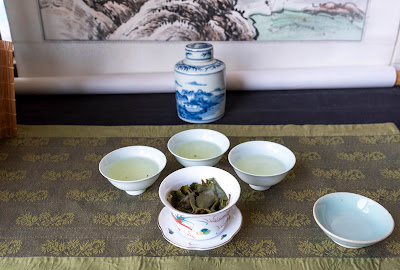 |
| FuShou (left) vs DYL (right) |
The first thing that strikes us is the color difference of the dry leaves: a yellow hue on FuShou shan and a green/blue hue for DYL! This should mean a higher oxidation level for FuShou Shan, which I brewed first here:
Then comes the brew of Da Yu Ling.
Conclusion: the DYL104K remains the emperor of Taiwan high mountain Oolongs. Don't brew it too strong, otherwise you'll miss its finesse. But if you are looking for brute force, then the FuShou Shan is more for you (or the Shan Lin Xi and the AliShan ShiZhuo).
Then comes the brew of Da Yu Ling.
The DYL brew looks lighter and the leaves less yellow, which suggests that the oxidation is indeed lighter.
In terms of scents, there are more similarities than differences. Both have the typical delicate flowery and buttery scents of top spring Oolongs. The major difference came in the taste. But before I continue, I would like to add that the quality of tea does not correlate linearly with the strength of taste. Maybe for some people it does, because they feel they get more taste bud stimulation for the buck. But for a more experienced palate, harmony and finesse also count. How controlled and smooth is the strength of the taste?
What struck me was that both Oolongs have an excellent aftertaste (even though I just used 2 grams each for this test)! The FuShou Shan feels actually more powerful, but the DYL104K feels sweeter and more refined.
Conclusion: the DYL104K remains the emperor of Taiwan high mountain Oolongs. Don't brew it too strong, otherwise you'll miss its finesse. But if you are looking for brute force, then the FuShou Shan is more for you (or the Shan Lin Xi and the AliShan ShiZhuo).





No comments:
Post a Comment